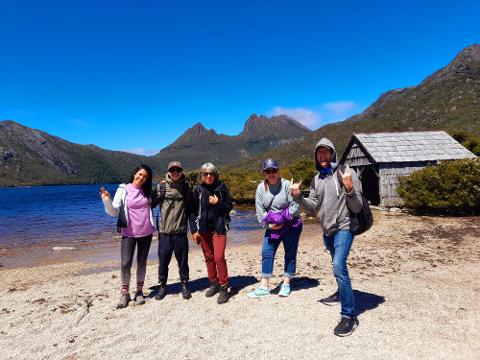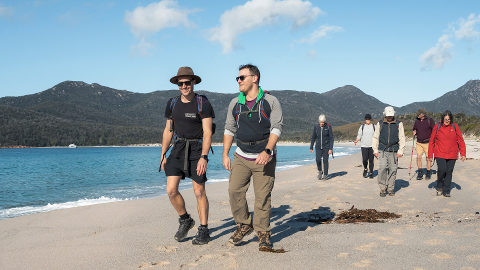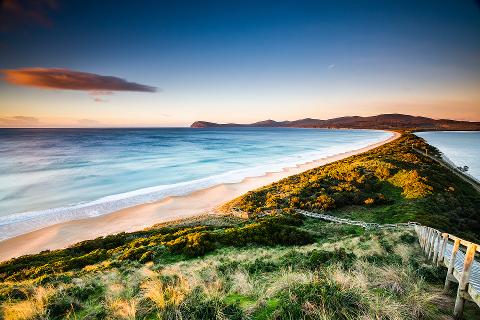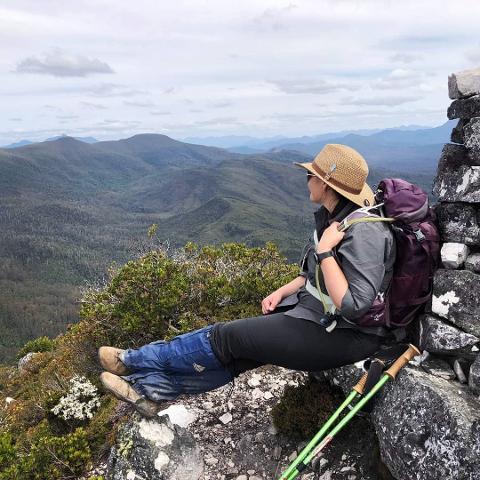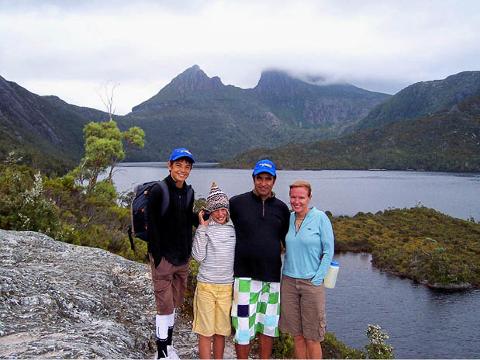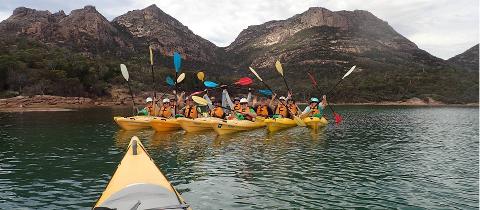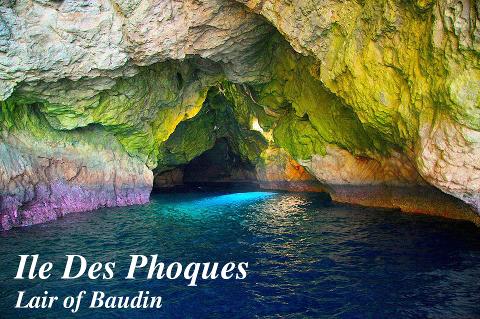Format Note: Today | 3 Day Forecast Day/Night
Tasmania delivers much to see and do year-round: festivals, watersports, mountain biking, food and drinks, historical day trips, and a wide option of hiking trails for your enjoyment. The Natural State also boasts 19 National Parks, with some of the world’s most exotic and rarest animals to discover. The temperature in Tasmania and Tasmania weather does fluctuate depending upon the time of year and where you are, so it is best to think ahead when planning, preparing, and packing for your trip. The high temperatures in the summer can reach 25 °C ( 77 °F ), with the coldest temperatures in winter reaching 0 °C ( 32 °F ). The record high in 2009 was 42.2 °C (108.0 °F) with the record low in 2020 being −14.2 °C (6.4 °F).
Here is a list of seasonal things to do and some packing tips.
Arguably, the best time of year to visit Tasmania is in the summer, from December to February, when it is warm and dry. Maximum temperatures average between 20 Celcius to 24 Celcius along the coast, and the valleys west of Hobart (the warmest locations) regularly rise above 25 Celcius. The Central Plateau is the coldest Tasmania has to offer, with temperatures ranging from 4 Celcius to rarely exceeding 17 Celcius.
Things To Do and Highlights
The available activities read like a list out of Sports Illustrated: There’s boating, scuba, swimming, fishing, biking, picnicking, hiking, and more.
Festivals, of which there are many, fill the calendar: The Taste of Tasmania, the Huon Agricultural Show, the Sydney to Hobart Yacht Race, the Cygnet Folk Festival and MONA FOMA (Museum of Old and New Arts Festival of Music and Arts), among others.
What to Pack
Pack light with comfortable walking shoes, breathable clothing, shade hat, sunscreen, and a lightweight jacket or sweater for the cooler evenings. And don’t forget your swimsuit!
March to May brings in the autumn coolness and harvest time. Average highs are just above 20 Celcius in the valleys and 15 Celcius along the coast, with lows around 11 Celcius to 7.6 Celcius. This is the best season for getting out to the farms and vineyards, as produce is at its peak and wines beckon for the tasting.
Things To Do and Highlights
The Autumn Festival is jam-packed with food, music, and activities. The colours of autumn offer spectacular photography opportunities, the Targa Tasmania Road Race will rev up your vacation, and Ten Days on the Island Art Festival is the largest arts and artisan fair in Tasmania. Yachting is always an option, as are hiking and walking tours.
What To Pack
Pack warmer clothing as the temperature can get chilly, especially at night and when the winds across the waters begin to pick up. Bring warm shoes, trousers, sleeves, and a jacket. Think “layers.”
September to November ushers in the springtime with a spectacular burst of colour. It is a season of frequent change, and snowfall is still common in the mountains through October. This is also the windiest time of year. Average temperatures range on the high side from 15.4 Celcius inland and 19 Celcius coastal to lows of 7 Celcius to 10 Celcius, respectively.
Things To Do and Highlights
The Bloomin’ Tulips Festival is a must-see for those who love flowers. A boat trip from Hobart to Port Arthur for the evening ghost tour is a visitor favourite, too. Other activities include hiking, biking, wine tasting, rafting on the many rivers, and visiting the stunning Tasmanian Royal Botanical Gardens.
What To Pack
It will be chilly, so pack your boots, a hat, a scarf, heavier clothing for layering against the colder nights, and a good jacket.
The winter months of June, July and August are the wettest and coldest, and there is considerable snowfall in the higher elevations. Temperatures are typically warmer than mainland Australia, and most of coastal Tasmania rarely drops below freezing. The average highs are from 12 Celcius (coastal) to 3 Celcius (inland), and the elevated inland areas average 0 Celcius.
Things To Do and Highlights
Winter may be the least crowded season in Tasmania, but there is nothing lifeless about a visit to the island during June, July, and August.
Snowshoeing the Overland Track is brisk and challenging. Consider a distillery tour or star gazing by a roaring fire on the beach. Visit the Chocolate Winterfest in Latrobe to sample chocolatiers’ indulgent confections. The Festival of Voices features all types of voice performers and singalongs. Dark Mofo features various entertainment options, the Winter Feast culinary delight, and the infamous nude swim on the Summer Solstice!
What To Pack
Pack rain gear, waterproof footwear, warm socks, a hat, scarf, gloves, a Bumbershoot, an extra set of clothes in case you forget your Bumbershoot and a good winter jacket.
Regardless of when you travel to Tasmania, remember to pack your camera to record what is sure to be a most memorable time on this unique Pacific island down under.
Hobart (Southeast Coast)
- Weather: Hobart, Tasmania’s capital, has a temperate climate with relatively mild seasons. Summers are warm, with temperatures between 17°C to 23°C (63°F to 73°F), and winters are cool, ranging from 4°C to 12°C (39°F to 54°F).
- What It Looks Like: The city is nestled between the Derwent River and Mount Wellington, which creates a stunning backdrop. In winter, Mount Wellington is often dusted with snow, while the harbour and waterfront areas are bustling in summer with boats and open-air markets.
- What It Feels Like: Hobart feels comfortable and sunny in summer, perfect for walking along the waterfront or exploring Salamanca Market. The air is crisp and chilly in winter, especially in the mornings and evenings, with cool winds blowing in from the river.
Current Weather in Hobart
Launceston (North)
- Weather: Launceston is located in the Tamar Valley and has slightly warmer summers than Hobart, with temperatures from 12°C to 26°C (54°F to 79°F), and cooler winters, with temperatures dropping to 2°C to 13°C (36°F to 55°F). Frosts are common in the winter.
- What It Looks Like: The city is known for its green parks and heritage buildings. In autumn, the foliage transforms into vibrant shades of orange and red. Cataract Gorge offers dramatic scenery with its cliffs and river.
- What It Feels Like: Summer's warmth feels vibrant and welcoming, with gentle breezes coming through the valley. Winter mornings can be frosty, and visitors will feel a sharp chill, especially during early morning tours or hikes.
Current Weather in Launceston
Cradle Mountain (Central Highlands)
- Weather: Cradle Mountain, part of the Tasmanian Wilderness World Heritage Area, has cooler, alpine weather year-round. Summer temperatures range from 5°C to 18°C (41°F to 64°F), while winter can be freezing, with temperatures between -1°C to 8°C (30°F to 46°F). Snow is common during winter, and rain can fall at any time of the year.
- What It Looks Like: This rugged, dramatic landscape is marked by mountains, lakes, and dense forests. In winter, the area is often snow-covered, and in summer, wildflowers bloom in the meadows. Mist frequently shrouds the mountain, creating an ethereal atmosphere.
- What It Feels Like: In summer, the air is cool and fresh, ideal for hiking but unpredictable with sudden showers or temperature drops. Winter is cold and snowy, with visitors experiencing a sharp, biting wind that makes the wilderness feel raw and untouched.
Current Weather in Cradle Mountain
Strahan (West Coast)
- Weather: Strahan experiences a temperate, maritime climate on the rugged west coast. Summers are mild, with temperatures between 13°C to 21°C (55°F to 70°F), and winters are cool, with temperatures from 5°C to 14°C (41°F to 57°F). Rain is frequent, especially in winter.
- What It Looks Like: Strahan sits on the edge of Macquarie Harbour, surrounded by temperate rainforests. The nearby Gordon River and the dunes of Ocean Beach offer stunning natural vistas. Overcast skies are typical, adding a moody, atmospheric feel to the town and its surrounding wilderness.
- What It Feels Like: The air is fresh, with a salty tang from the sea. Summer days are pleasant and cool, perfect for river cruises or rainforest exploration. Winter brings a damp chill, and the frequent rain makes the town feel cozy and remote, with a sense of being at the world's edge.
Current Weather Strahan
Freycinet (East Coast)
- Weather: Freycinet on the east coast enjoys more sunshine than other parts of Tasmania. Summers are warm, with temperatures ranging from 12°C to 24°C (54°F to 75°F), while winters are milder, with temperatures between 6°C to 15°C (43°F to 59°F).
- What It Looks Like: Pristine beaches, turquoise waters, and the pink-hued Hazards Mountains provide a stunning backdrop.
- What It Feels Like: Summer feels sunny and vibrant, perfect for beach days or hikes. Winter brings a fresh, mild breeze, ideal for exploring without the chill of Tasmania’s other regions.
Current Weather in Freycinet
Tasmania’s regions offer diverse weather experiences. Hobart ( Northeast Coast ) and Launceston ( North ) feature milder, more predictable climates, while Cradle Mountain ( Central Highlands ) and Strahan ( West ) deliver wilder, more dramatic conditions. Freycinet ( East Coast ) enjoys warmer, sunnier weather, making it a popular beachgoer spot. Visitors should be prepared for changing conditions by bringing rain jackets, layers, and sturdy footwear, especially outdoors. Whether facing cool alpine winds or coastal breezes, Tasmania’s natural beauty and fresh air make every moment invigorating and memorable.

















